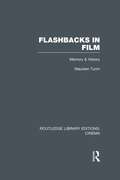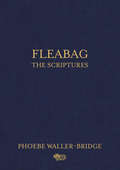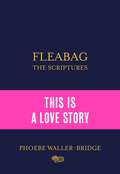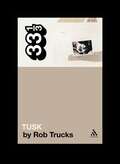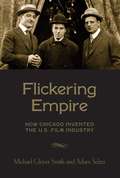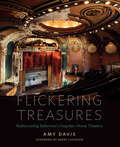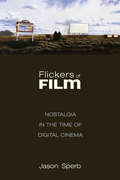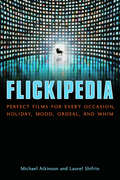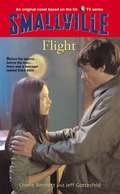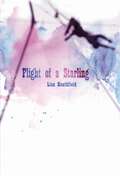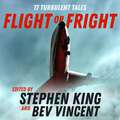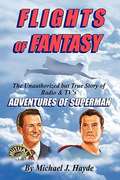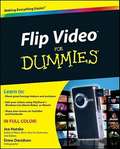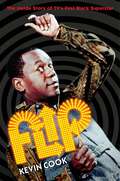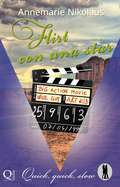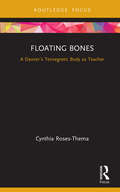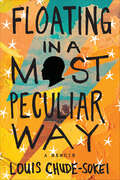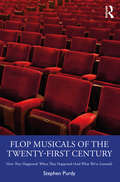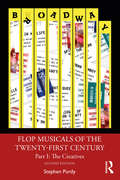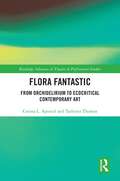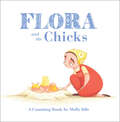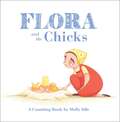- Table View
- List View
Flashbacks in Film: Memory & History (Routledge Library Editions: Cinema)
by Maureen TurimThe flashback is a crucial moment in a film narrative, one that captures the cinematic expression of memory, and history. This author’s wide-ranging account of this single device reveals it to be an important way of creating cinematic meaning. Taking as her subject all of film history, the author traces out the history of the flashback, illuminating that history through structuralist narrative theory, psychoanalytic theories of subjectivity, and theories of ideology. From the American silent film era and the European and Japanese avant-garde of the twenties, from film noir and the psychological melodrama of the forties and fifties to 1980s art and Third World cinema, the flashback has interrogated time and memory, making it a nexus for ideology, representations of the psyche, and shifting cultural attitudes.
Fleabag: The Scriptures
by Phoebe Waller-BridgeGo deeper into the groundbreaking, Emmy-winning series with this must-have collection—&“a completist&’s dream of a book, including the show&’s full scripts and Waller-Bridge&’s commentary&” (Vogue). &“Her coat falls open. She only has her bra on underneath. She pulls out the little sculpture of the woman with no arms. It sits on her lap. Two women. One real. One not. Both with their innate femininity out.&” Phoebe Waller-Bridge&’s critically acclaimed, utterly unique series Fleabag took the world by storm with its piercing dialogue, ruthlessly dry wit, and deeply human drama. In Fleabag: The Scriptures, Waller-Bridge brings together for the first time the complete filming scripts of the first and second seasons, annotated with never-before-seen stage directions and exclusive commentary on her creative process and the making of the series. Now recognized as one of today&’s most essential voices, she delivers powerful insights into her now-iconic protagonist: the hilarious, emotionally damaged, sexually unapologetic woman who can make viewers laugh, cry, and cringe in a single scene. Essential for any fan, Fleabag: The Scriptures is the ultimate companion to a landmark series.
Fleabag: The Sunday Times Bestseller (Nhb Modern Plays Ser.)
by Phoebe Waller-BridgeBestseller in the UK, Sunday Times, November 2019.The complete Fleabag. Every Word. Every Side-eye. Every Fox.Fleabag: The Scriptures includes new writing from Phoebe Waller-Bridge alongside the filming scripts and the never-before-seen stage directions from the Golden Globe, Emmy and BAFTA winning series. 'Perfect' Guardian'Perfect' Daily Telegraph'Perfect' Stylist 'Perfect' Independent'Perfect' Evening Standard 'Perfect' Metro'Perfect' Irish Times 'Perfect' RTE'Perfect' Spectator'Perfect' Refinery29'Perfect' Catholic Herald'Perfection' Financial Times***HAIRDRESSERNO.(pointing to Claire)That is EXACTLY what she asked for.FLEABAGNo it's not. We want compensation.HAIRDRESSERClaire?CLAIREI've got two important meetings and I look like a pencil.HAIRDRESSERNO. Don't blame me for your bad choices. Hair isn't everything.FLEABAGWow.HAIRDRESSERWhat?FLEABAGHair. Is. Everything. We wish it wasn't so we could actually think about something else occasionally. But it is. It's the difference between a good day and a bad day. We're meant to think that it is a symbol of power, a symbol of fertility, some people are exploited for it and it pays your fucking bills. Hair is everything, Anthony.
Fleetwood Mac's Tusk (33 1/3 Ser. #77)
by Rob TrucksAfter Rumours became the best-selling single album of all-time, Fleetwood Mac asked Warner Brothers Records to buy them a studio (the label refused, costing both Warner Brothers and the band significant cash in the long run) and then handed the reins to their guitarist and resident perfectionist Lindsey Buckingham, a fusion of factors that led Tusk to become the first record in history to cross the million dollar threshold in production costs. “You know,” Buckingham told me, “we had this ridiculous success with Rumours. And at some point, at least in my perception, the success of that detached from the music, and it was more about the phenomenon. We were poised to do another album, and I guess because the axiom 'If it works, run it into the ground’ was prevalent then, we were probably poised to do Rumours II. I don’t know how you do that, but somehow my light bulb that went off was, ‘Let’s just not do that. Let’s very pointedly not do that.’” Here, Rob Trucks talks to Lindsey Buckingham, as well as members of Animal Collective, Camper Van Beethoven, the New Pornographers, Wolf Parade, the Fleetwood Mac tribute band. Tusk, and the USC Trojan marching band in order to chart both the story and the impact of an album born of personal obsession and a stubborn unwillingness to compromise.
Fleetwood: My Life and Adventures in Fleetwood Mac
by Mick Fleetwood Stephen DavisHere, for the first time, one of rock-and-roll's mastermusicians of the 60s describes how he nurtured a band that dominated the seventies, came back in the eighties, and survives into the nineties--its fourth decade--as one of the most-loved acts in the world
Flickering Empire: How Chicago Invented the U.S. Film Industry
by Adam Selzer Michael Glover SmithTells the fascinating but too little known story of how Chicago served as the unlikely capital of film production in America in the years prior to the rise of Hollywood (1907-1913)
Flickering Empire: How Chicago Invented the U.S. Film Industry
by Adam Selzer Michael Glover SmithFlickering Empire tells the fascinating yet little-known story of how Chicago served as the unlikely capital of American film production in the years before the rise of Hollywood (1907–1913). As entertaining as it is informative, Flickering Empire straddles the worlds of academic and popular nonfiction in its vivid illustration of the rise and fall of the major Chicago movie studios in the mid-silent era (principally Essanay and Selig Polyscope). Colorful, larger-than-life historical figures, including Thomas Edison, Charlie Chaplin, Oscar Micheaux, and Orson Welles, are major players in the narrative—in addition to important though forgotten industry titans, such as "Colonel" William Selig, George Spoor, and Gilbert "Broncho Billy" Anderson.
Flickering Treasures: Rediscovering Baltimore's Forgotten Movie Theaters
by Amy DavisThe riveting story of Baltimore’s movie theaters over the past century, eloquently told through extraordinary photographs and poignant reminiscences.2018 Winner of the Preservation Award of the Baltimore HeritageBaltimore has been home to hundreds of theaters since the first moving pictures flickered across muslin sheets. These monuments to popular culture, adorned with grandiose architectural flourishes, seemed an everlasting part of Baltimore’s landscape. By 1950, when the city’s population peaked, Baltimore’s movie fans could choose from among 119 theaters. But by 2016, the number of cinemas had dwindled to only three. Today, many of the city’s theaters are boarded up, even burned out, while others hang on with varying degrees of dignity as churches or stores. In Flickering Treasures, Amy Davis, an award-winning photojournalist for the Baltimore Sun, pairs vintage black-and-white images of opulent downtown movie palaces and modest neighborhood theaters with her own contemporary full-color photographs, inviting us to imagine Charm City’s past as we confront today’s neglected urban landscape. Punctuated by engaging stories and interviews with local moviegoers, theater owners, ushers, and cashiers, plus commentary from celebrated Baltimore filmmakers Barry Levinson and John Waters, the book brings each theater and decade vividly to life. From Electric Park, the Century, and the Hippodrome to the Royal, the Parkway, the Senator, and scores of other beloved venues, the book delves into Baltimore’s history, including its troubling legacy of racial segregation. The descriptions of the technological and cultural changes that have shaped both American cities and the business of movie exhibition will trigger affectionate memories for many readers. A map and timeline reveal the one-time presence of movie houses in every corner of the city, and fact boxes include the years of operation, address, architect, and seating capacity for each of the 72 theaters profiled, along with a brief description of each theater’s distinct character. Highlighting the emotional resonance of film and the loyalty of Baltimoreans to their neighborhoods, Flickering Treasures is a profound story of change, loss, and rebirth.
Flickering Treasures: Rediscovering Baltimore's Forgotten Movie Theaters
by Amy DavisThese vintage and contemporary images of Baltimore movie palaces explore the changing face of Charm City with stories and commentary by filmmakers.Since the dawn of popular cinema, Baltimore has been home to hundreds of movie theaters, many of which became legendary monuments to popular culture. But by 2016, the number of cinemas had dwindled to only three. Many theaters have been boarded up, burned out, or repurposed. In this volume, Baltimore Sun photojournalist Amy Davis pairs vintage black-and-white images of downtown movie palaces and modest neighborhood theaters with her own contemporary color photos. Flickering Treasures delves into Baltimore’s cultural and cinematic history, from its troubling legacy of racial segregation to the technological changes that have shaped both American cities and the movie exhibition business. Images of Electric Park, the Century, the Hippodrome, and scores of other beloved venues are punctuated by stories and interviews, as well as commentary from celebrated Baltimore filmmakers Barry Levinson and John Waters.A map and timeline reveal the one-time presence of movie houses in every corner of the city, and fact boxes include the years of operation, address, architect, and seating capacity for each of the 72 theaters profiled, along with a brief description of each theater’s distinct character.
Flickers of Film
by Jason SperbWhether paying tribute to silent films in Hugo and The Artist or celebrating arcade games in Tron: Legacy and Wreck-It-Ralph, Hollywood suddenly seems to be experiencing a wave of intense nostalgia for outmoded technologies. To what extent is that a sincere lament for modes of artistic production that have nearly vanished in an all-digital era? And to what extent is it simply a cynical marketing ploy, built on the notion that nostalgia has always been one of Hollywood's top-selling products? In Flickers of Film, Jason Sperb offers nuanced and unexpected answers to these questions, examining the benefits of certain types of film nostalgia, while also critiquing how Hollywood's nostalgic representations of old technologies obscure important aspects of their histories. He interprets this affection for the prehistory and infancy of digital technologies in relation to an industry-wide anxiety about how the digital has grown to dominate Hollywood, pushing it into an uncertain creative and economic future. Yet he also suggests that Hollywood's nostalgia for old technologies ignores the professionals who once employed them, as well as the labor opportunities that have been lost through the computerization and outsourcing of film industry jobs. Though it deals with nostalgia, Flickers of Film is strikingly cutting-edge, one of the first studies to critically examine Pixar's role in the film industry, cinematic representations of videogames, and the economic effects of participatory culture. As he takes in everything from Terminator: Salvation to The Lego Movie, Sperb helps us see what's distinct about this recent wave of self-aware nostalgic films--how Hollywood nostalgia today isn't what it used to be.
Flickipedia: Perfect Films for Every Occasion, Holiday, Mood, Ordeal, and Whim
by Michael Atkinson Laurel ShifrinFrom the jolting summer electricity of Jaws to mending a broken heart with When Harry Met Sally, this entertaining and unique guide takes movies off the silver screen, offering viewing recommendations tailored to everyday situations. Equipped with more than 1,300 movie suggestions, this informative resource covers every landmark event, social situation, and annual occurrence from having a baby to watching the Super Bowl. Organized by categories such as holidays, seasonal passages, life phases, and emotional trials and eruptions, this guide recommends movies that readers may not be familiar with, while also featuring the popular classic movie pairings, such as It's a Wonderful Life at Christmas and The Ten Commandments at Passover. Whether readers are looking for a scare on Halloween, packing for a road trip, or yearning for a bygone era, this innovative movie guide has the perfect recommendation.
Flight (Smallville Young Adult #3)
by Cherie Bennett Jeff GottesfeldThis third adventure based on the WB's hit TV series is by two noted authors who have written screenplays for the show, and follows a young, legendary Clark Kent, Lana Lang, and Lex Luthor, complete with all the thrills and strange happenings that fans of "Smallville" expect.
Flight of a Starling
by Lisa HeathfieldBest friends and sisters Lo and Rita have spent their lives flying through the air on the trapeze under the lights in the big top. The nomadic circus community is a close-knit family, but those bonds are threatened as secrets and lies surface and Lo finds forbidden love with a boy from outside the circus. The two sisters find themselves at odds with each other for the first time as they both search for love and test the limits of family loyalty. Lo must face up to a family member's deception and navigate her newfound love. Will she manage to land on her feet?
Flight or Fright: 17 Turbulent Tales Edited by Stephen King and Bev Vincent
by Ambrose Bierce Stephen King Roald Dahl Ray Bradbury John Varley Dan Simmons Michael Lewis Richard Matheson Joe Hill Tom Bissell Bev Vincent Cody Goodfellow E.C. Tubb Sir Arthur Conan Doyle David Schow Peter Treemayne James L. DickeyFasten your seatbelts for an anthology of turbulent tales curated by Stephen King and Bev Vincent.This exciting new collection, perfect for airport or aeroplane reading, includes an original introduction and story notes for each story by Stephen King, and brand new stories from Stephen King and Joe Hill.Stephen King hates to fly.Now he and co-editor Bev Vincent would like to share this fear of flying with you.Welcome to Flight or Fright, an anthology about all the things that can go horribly wrong when you're suspended six miles in the air, hurtling through space at more than 500 mph and sealed up in a metal tube (like - gulp! - a coffin) with hundreds of strangers. All the ways your trip into the friendly skies can turn into a nightmare, including some we'll bet you've never thought of before... but now you will the next time you walk down the jetway and place your fate in the hands of a total stranger.Featuring brand new stories by Joe Hill and Stephen King, as well as fourteen classic tales and one poem from the likes of Richard Matheson, Ray Bradbury, Roald Dahl, Dan Simmons, and many others, Flight or Fright is, as King says, "ideal airplane reading, especially on stormy descents... Even if you are safe on the ground, you might want to buckle up nice and tight."Book a flight for this terrifying new anthology that will have you thinking twice about how you want to reach your final destination.Contents:Introduction by Stephen KingCargo by E. Michael LewisThe Horror of the Heights by Sir Arthur Conan DoyleNightmare at 20,000 Feet by Richard MathesonThe Flying Machine by Ambrose BierceLucifer! by E.C. TubbThe Fifth Category by Tom BissellTwo Minutes Forty-Five Seconds by Dan SimmonsDiablitos by Cody GoodfellowAir Raid by John VarleyYou Are Released by Joe HillWarbirds by David J. SchowThe Flying Machine by Ray BradburyZombies on a Plane by Bev VincentThey Shall Not Grow Old by Roald DahlMurder in the Air by Peter TremayneThe Turbulence Expert by Stephen KingFalling by James L. DickeyAfterword by Bev Vincent(P)2018 Simon & Schuster Audio
Flights of Fantasy: The Unauthorized but True Story of Radio & TV's Adventures of Superman
by Michael J. HaydeSuperman isn't going away anytime soon. The Man of Steel thrives, outlasting flagging comic magazine sales, mediocre box office returns, dwindling Nielsen ratings and repeated attempts to give him a makeover. His owners kill him off, and he refuses to stay dead. He's still the consummate superhero; the most recognizable comic book character of all time and one of American literature's most famous creations. How did that happen? This book will answer that question.
Flip Video For Dummies
by Joel Hutsko Drew DavidsonThe full-color guide to shooting great video with the Flip Video camera The inexpensive Flip Video camera is currently one of the hottest must-have gadgets. It's portable and connects easily to any computer to transfer video you shoot onto your PC or Mac. Although the Flip Video camera comes with a quick-start guide, it lacks a how-to manual, and this full-color book fills that void! Packed with full-color screen shots throughout, Flip Video For Dummies shows you how to shoot the best possible footage in a variety of situations. You'll learn how to transfer video to your computer and then edit it and share your Flip Video movies. Walks you through the basics of using a Flip Video camera and connecting it to your Mac or PC Explains how to shoot footage indoors, outdoors, and even underwater Covers editing video footage using FlipShare, Windows Movie Maker, or iMovie Shows you how to share Flip Video movies or upload them to YouTube, Facebook, and other sites You'll flip out when you discover just how easy a Flip Video camera can be when you have this book by your side!
Flip: The Inside Story of TV's First Black Superstar
by Kevin CookThe rags-to-riches story of a groundbreaking, beloved entertainer When The Flip Wilson Show debuted in 1970, black faces were still rare on television, black hosts nonexistent. So how did Clerow “Flip” Wilson go from Jersey City grade-school dropout to national celebrity, heralded on the cover of Time as “TV’s First Black Superstar”? Flip is a candid, entertaining biography of a consummate comedian who changed the face of American popular culture. Kevin Cook chronicles Flip’s meteoric rise through the Chitlin’ Circuit of segregated nightclubs to his breakthrough on Johnny Carson’s Tonight Show to his hit variety show, on which he created such outrageous and hilarious characters as the sassy Geraldine and flock-fleecing Reverend Leroy. As one of the biggest stars of his time, he performed and partied with Richard Pryor, George Carlin, Michael Jackson, Elvis Presley, and other stars of the 1970s. Drawing on interviews with family, friends, and celebrities, Cook delivers the inspiring story of a complex man who broke the prime-time color barrier, blazing a trail for generations of African American performers who followed him. .
Flirt con una star (Quick, quick, slow - Club di Danza Lietzensee #2)
by Annemarie NikolausTanja Walters è innamorata, apparentemente senza speranza, di Micky Hasloff, da anni suo compagno di square dance. In realtà Micky nasconde i suoi sentimenti dietro ai battibecchi. Poi gli square dancer vengono scritturati per un western in cui l’attore spagnolo Manolo Rioja è il protagonista. La star era l’idolo adolescenziale di Tanja e lei gli fa gli occhi dolci: lei è senza dubbio attraente quanto le groupie di cui lui si circonda di solito. Micky Hasloff osserva con rabbia crescente come lei si getta al collo di Rioja. Alla fine sabota le riprese. Che salti pure il contratto per il film, se Tanja non ne vuole sapere di lui. Poi Micky fa la conoscenza della moglie di Rioja, in stato di avanzata gravidanza, e apprende che le groupie accanto a lui sono tutte quante modelle pagate. Questo finalmente lo convince che la star non è affatto interessata a Tanja. Ma questo lo aiuterà? Riuscirà Micky a superare la sua paura di un rifiuto e rivelare a Tanja i suoi sentimenti? Romanzo d’amore della serie “Quick, quick, slow - Club di Danza Lietzensee”. Ogni libro della serie è un romanzo a sé e può essere letto indipendentemente dagli altri.
Floating Bones: A Dancer's Tensegretic Body as Teacher
by Cynthia Roses-ThemaFloating Bones charts the author’s journey into tensegrity, which begins in ballet and culminates in a model for addressing one’s body as a teacher. Tensegrity flips traditional biomechanical models such that instead of support coming from the bones, the bones float, and it is the muscles and other soft connective tissue that provide support for the moving body. Using the model of tensegretic experience, Roses-Thema connects somatics, cognition, rhetoric, and reflective practices detailing the means that constructed approaching the body as a teacher. This study presents the argument for extending the models of thinking to include bodily thinking, by citing how the experiential perspective of tensegrity constructs physical evidence of the rhetorical concept, metis, where the body thinks as it moves. This book will be of great interest to students, scholars, and practitioners of dance, theater, and sociology.
Floating In A Most Peculiar Way: A Memoir
by Louis Chude-SokeiThe astonishing journey of a bright, utterly displaced boy, from the short-lived African nation of Biafra, to Jamaica, to the harshest streets of Los Angeles—a searing memoir that adds fascinating depth to the coming-to-America storyThe first time Chude-Sokei realizes that he is &“first son of the first son&” of a renowned leader of the bygone African nation is in Uncle Daddy and Big Auntie&’s strict religious household in Jamaica, where he lives with other abandoned children. A visiting African has just fallen to his knees to shake him by the shoulders: &“Is this the boy? Is this him?&”Chude-Sokei&’s immersion in the politics of race and belonging across the landscape of the African diaspora takes a turn when his traumatized mother, who has her own extraordinary history as the onetime &“Jackie O of Biafra,&” finally sends for him to come live with her. In Inglewood, Los Angeles, on the eve of gangsta rap and the LA riots, it&’s as if he&’s fallen to Earth. In this world, anything alien—definitely Chude-Sokei&’s secret obsession with science fiction and David Bowie—is a danger, and his yearning to become a Black American gets deeply, sometimes absurdly, complicated. Ultimately, it is a boisterous pan-African family of honorary aunts, uncles, and cousins that becomes his secret society, teaching him the redemptive skill of navigating not just Blackness, but Blacknesses, in his America.
Flop Musicals of the Twenty-First Century: How They Happened, When They Happened (And What We’ve Learned)
by Stephen PurdyFlop Musicals of the Twenty-First Century offers a provocative and revealing historical narrative of a group of musicals that cost millions, that were created by world-renowned writers and directors, and that had spectacular potential… but bombed anyway. Stephen Purdy asks the reader to consider what the legendary creators of Les Misérables, pop superstar Elton John, and wunderkind Julie Taymor have in common besides being inspired storytellers of iconic Broadway musicals. The answer is that they also all created shows that, for one reason or a dozen, flopped. This book shares the story of what can happen when formidable creative teams of sell-out musicals attempt to repeat their success but miss the mark. First-hand accounts from the cast members, backstage staff, and the creative team, combined with a wealth of secondary sources gathered from press articles, reviews, and critical commentary, offer an intriguing insight into the factors behind success and failure in the musical theatre business. This is a fascinating book for students, scholars, practitioners, and fans of musical theatre that contains thoughtful observations about luck and creative differences, botched adaptations, and alienated audiences, all of which can determine the fate of a musical.
Flop Musicals of the Twenty-First Century: Part I: The Creatives
by Stephen PurdyFlop Musicals of the Twenty-First Century offers a provocative and revealing historical narrative of a group of musicals that cost millions and had spectacular potential ... but bombed anyway. Stephen Purdy examines at length the production histories, which are all bound together by a common thread. The book focuses the lens on several seemingly infallible theatre creatives who weren’t destined to repeat their successes with the shows discussed in this volume. As such, Purdy grounds the discussion by examining what the legendary creators of Les Misérables, pop superstar Elton John, wunderkind Julie Taymor, and many others have in common besides being inspired storytellers of iconic Broadway musicals. The answer is that they also all created shows that, for one reason or a dozen, didn’t find an audience. Flop Musicals of the Twenty-First Century shares the story of what can happen when formidable creative teams of sell-out musicals attempt to re-create their success but miss the mark. This is an engaging book for students, practitioners, and fans of musical theatre that contains thoughtful observations about luck and creative differences, botched adaptations, and alienated audiences, all of which can determine the fate of a musical.
Flora Fantastic: From Orchidelirium to Ecocritical Contemporary Art (ISSN)
by Corina L. Apostol Tashima ThomasThis book delves deep into colonial botany, utilizing mediums such as historical investigation, cinema, photography, live performance, and installation art.Surveying perspectives from Europe, the U.S., Africa, Southeast Asia, Latin America, and the Caribbean, it positions plants—both native and foreign—as active participants and silent observers in colonial narratives. By viewing through the prism of visual and performance art, this book touches on diverse topics like the economic value of plants, traditional and Western medicine, state‑endorsed scientific endeavors, migration patterns of flora and people, bio‑contact areas, nationalistic views, and botanical diplomacy. It offers fresh insights into colonial botany’s multifaceted history, emphasizing the intricate interplay between Eastern, Western, and Southern nations during the twentieth century and its enduring impact today.Serving as an invaluable addition to the realms of art history, performance studies, botany, visual culture, decolonial initiatives, and environmental politics, this book arrives at a pivotal moment when its insights are most crucial.
Flora and the Chicks: A Counting Book (Flora and Her Feathered Friends)
by Molly IdleInspired by the main character of the Caldecott Honor book Flora and the Flamingo, this new series of board books is perfect for the very youngest Flora fans. When a nest of eggs begins to hatch, how will Flora ever keep up with so many chicks? Featuring fold-out pages and Molly Idle's graceful artwork, this adorable counting book will delight young children as they master new words and concepts.
Flora and the Chicks: A Counting Book by Molly Idle
by Molly IdleInspired by the main character of the Caldecott Honor book Flora and the Flamingo, this new series of board books is perfect for the very youngest Flora fans. When a nest of eggs begins to hatch, how will Flora ever keep up with so many chicks? Featuring fold-out pages and Molly Idle's graceful artwork, this adorable counting book will delight young children as they master new words and concepts.
